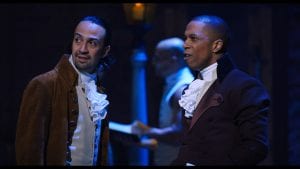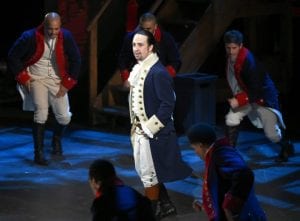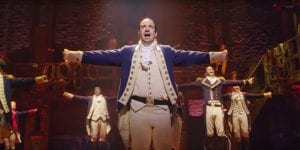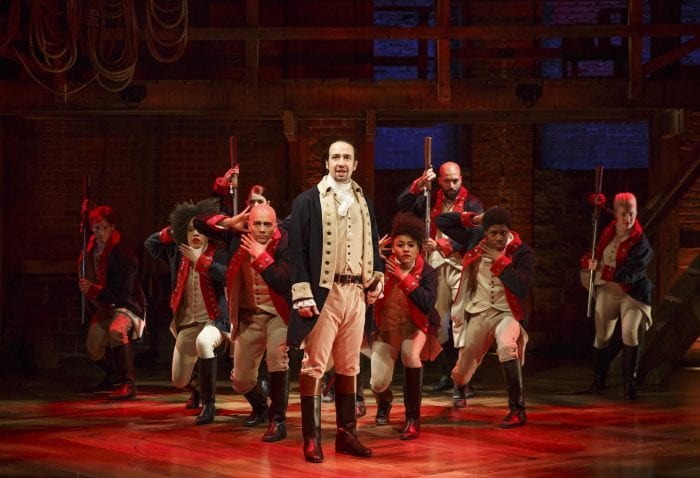Reviewed By Jeffrey Sanzel
No single theatrical event of the past ten years has had the presence of the musical Hamilton. The powerhouse blockbuster crossed into everyday culture unlike any previous work in the American theater. Eleven Tony-Awards and the Pulitzer Prize is only the beginning of the list of accolades and honors Hamilton has received. Ardent fans in New York and across the country guaranteed years if not decades of sold-out performances.
In full disclosure, I saw the Broadway production as well as the national tour. In 1923, literary critic Samuel Taylor Coleridge said of Edmund Kean: “To see him act, is like reading Shakespeare by flashes of lightning.” Until I sat in a theater and watched Hamilton, I had not truly appreciated this statement. (Theatre Three alum/Long Island native Ryan Alvarado was the standby for Hamilton, Burr, and King George in the tour. I had the great joy of seeing his extraordinary performance in the titular role in San Francisco.)
 Hamilton: An American Musical (its full title) is the sole creation of the unparalleled Lin-Manuel Miranda who had already risen to prominence with his In the Heights. Miranda used the Ron Chernow biography Hamilton (2004) as his source, but this is no traditional musical biopic. With his unique book, music, and lyrics, he has fashioned a celebration unlike any other, and in doing so, has redefined what theater can be.
Hamilton: An American Musical (its full title) is the sole creation of the unparalleled Lin-Manuel Miranda who had already risen to prominence with his In the Heights. Miranda used the Ron Chernow biography Hamilton (2004) as his source, but this is no traditional musical biopic. With his unique book, music, and lyrics, he has fashioned a celebration unlike any other, and in doing so, has redefined what theater can be.
The score is flawless alchemy, drawing from hip hop, R&B, pop, and soul as well as traditional musical theater. Each song is a crafted gem of tune and words, perfectly fitting the moment and the character. The book alternates between the historical and the personal, shifting seamlessly from one to the other. Director Thomas Kail and choreographer Andy Blankenbuehler clearly understood Miranda’s intentions as their staging is both breathtaking and clear, synthesizing every moment, every beat.
The casting of people of color is not about color-blind or color-conscious casting. It is not a theatricalization or a nod towards political correctness. It can be taken as a bold statement about the founding of this country, including its references to immigration. It is a fusion of history and time, reflecting both its historical roots and the era in which it first appeared. However, it is a different world from when Hamilton opened in 2015, and the musical’s resonance is quite different in 2020.
The Hamilton that made its debut July 3 on Disney Plus is edited from three live performances in 2016 plus several scenes that were filmed in an empty theater to provide the opportunity for close-ups. Christmas has come early because this is a gift.
 Over the years, there have been various attempts to bring the experience of live theater to television with varying success. The American Playhouse presentation of Into the Woods (1991) was one of the stronger examples, featuring the show’s original cast. The Public Theatre’s presentation of The Apple Plays, composed of four plays by Richard Greenburg, worked extremely well. It’s interesting to note that a fifth Zoom/COVID play presented in April — without an audience — was the best of all of them.
Over the years, there have been various attempts to bring the experience of live theater to television with varying success. The American Playhouse presentation of Into the Woods (1991) was one of the stronger examples, featuring the show’s original cast. The Public Theatre’s presentation of The Apple Plays, composed of four plays by Richard Greenburg, worked extremely well. It’s interesting to note that a fifth Zoom/COVID play presented in April — without an audience — was the best of all of them.
The recent line of live productions made for television — a clumsy Sound of Music, an overly rewritten The Wiz, a painfully wrong-headed Peter Pan — are examples of how not to do it. Oddly, Grease managed to capture some of the excitement and energy of a live performance — highlighted by actors rushing from soundstage to soundstage in golf carts. While it’s not exactly theater, the “live” element was maintained.
This is a long way of saying that there is always a danger of trying to capture those “flashes of lighting.”
However, stage director Kail has wisely chosen to offer as close to a faithful representation of seeing it in the theater as possible. The majority of the taping is in wide-shots that allow for the scope of the production, but there is still a liberal use of close-ups as well as shots from backstage towards the audience, from the wings, etc. Kail emphasizes the big picture but knows when to bring us in to the individuals. The compensation for not being “in the room where it happens” is that we are given an opportunity to see myriad details that we certainly would have missed in the theater.
 One of the treasures of this recorded Hamilton is that it preserves the original company. And this cast is exceptional: a group of young (only two casts members were even in their forties) and astoundingly talented singer/dancer/actors execute a story with not only precision and commitment but unparalleled joy.
One of the treasures of this recorded Hamilton is that it preserves the original company. And this cast is exceptional: a group of young (only two casts members were even in their forties) and astoundingly talented singer/dancer/actors execute a story with not only precision and commitment but unparalleled joy.
As Hamilton, Miranda mines both the humor and pathos. The pain he shows in “It’s Quiet Up Town” is only matched by Phillip Soo’s as Eliza Schuler Hamilton singing “Burn.” Daveed Diggs plays the Marquis de Lafayette with great flair but it his outrageous Thomas Jefferson and “What’d I Miss?” that brings down the house.
Leslie Odom Jr. balances the fence-sitting reserve of Aaron Burr with his fierce, underlying desire for power and position; Odom brings reality to Burr’s complicated psyche and his “The Room Where It Happens” is a breath-taking showstopper.
Jonathan Groff literally foams at the mouth as King George, who is simultaneously hilarious and dangerous. Renée Elise Goldsberry’s exposed honesty as Angelica Schuyler shows the entire range of human emotions in “Satisfied,” the counterpoint to her sister’s “Helpless.”
Christopher Jackson brings dignity and humility to George Washington, especially in his farewell “One Last Time.” And while several principals play dual roles, none is better than Okieriete Onaodowan as the brash Hercules Mulligan and the almost blushing James Madison; it truly is like watching two entirely different performers.
Thousands of words have been written on Hamilton but none can capture the magic of this landmark work of art. It should — no, must — be seen. “Flashes of lightning?” Hamilton is a full-on electrical storm.
Rated PG-13, Hamilton: An American Musical is now available on Disney Plus.





